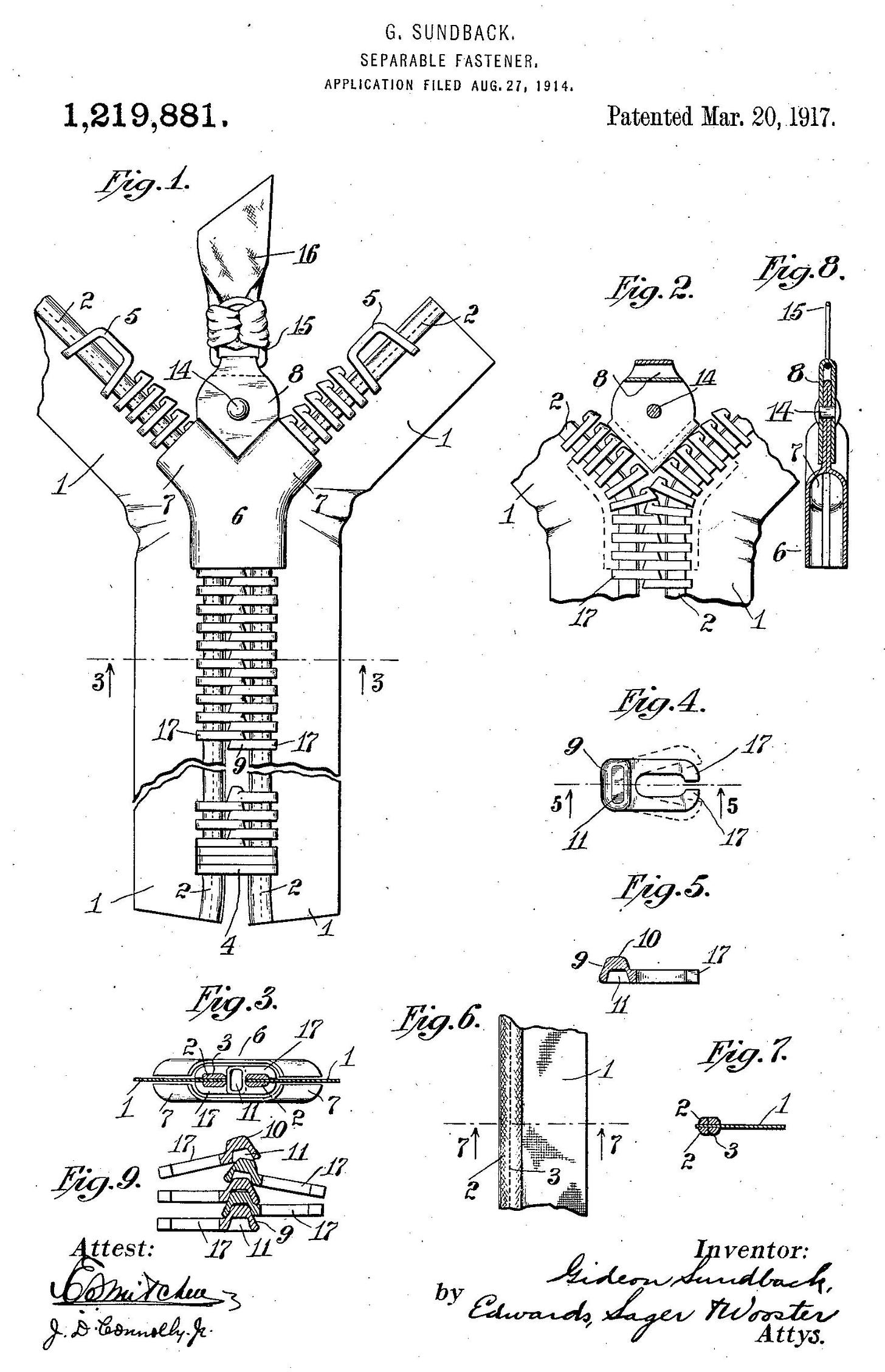It’s Design Lobster #90 and we’re just about holding things together. This week we’re exploring the history of the zipper and some rather unusual buttons. Unzip your mind and read on 🤐
✨Enjoying Design Lobster? Please share it with a friend, colleague or fellow designer.
Question: Who invented the zip?
I’ve been nerding out recently leaning about the history of the zip, one of those tiny marvels of modern life that flies under the radar of our appreciation.
Patents of mechanisms that approached the size and shape of a zip can be seen as early as 1851 but it is not until an engineer called Whitcomb Judson patented his Clasp Locker and Unlocker in 1893 that the story really begins. He was interested in finding a replacement for buttons on high shoes like boots, which were notoriously time consuming to take off and on. His patent, which describes a system with a slider that forces wire hooks into opposing eyes, was purchased by the Automatic Hook and Eye Company who financed its development into a product called the C-curity fastener, which you can see below.
Unfortunately, despite working well in the lab, these fasteners had a tendency to pop open at inopportune times which hampered sales. It was not until a Swedish engineer called Gideon Sundback joined the company in 1908 that these setbacks would be overcome. Sundback became obsessed with how to make these fasteners work reliably and produced a stream of patents over the next ten years. His key innovation was to move away from a hook entirely. His 1917 patent (at the top) shows the design that went into mass production, where each member is effectively a deep spoon, whose convex and concave surfaces are guided into each other and form a solid but flexible connection when closed.
But even when the technical and manufacturing challenges were overcome, the Automatic Hook and Eye faced the challenge of creating demand for an expensive product that required costly changes to production lines and uncertain consumer acceptance. Success finally came in the form of the 1923 Zipper Boot by a company called Goodrich. Their President Bertram Work reportedly came up with the name ‘zipper’, insisting they needed an action word for marketing rather than the cumbersome ‘hookless fastener’. By the early 1930’s fashion designers like Elsa Schiaparelli were using zips on runways, which lead to their mass acceptance and the ubiquity we see today. Apparently, 1.2 million miles of zips are now produced each year 😲
Design takeaway: What would it take for your design to be accepted by the mass market?
👢 YKK, who make most of the world’s zips, released a range made from ocean-sourced plastic
Object: Habitat button
These curious buttons were made nearly entirely of glass in order to showcase natural objects. In the example above, a sea scene has been created using fragments of seaweed and coral. Other so-called ‘Habitat’ buttons, might contain dried flowers, insects or even locks of human hair. They became fashionable during the Enlightenment when a mania for collecting and cataloguing specimens from the natural and human worlds overcame Western intelligentsia. Learned men and women would wear them on their clothes as miniature display cases that communicated their interests. I think of them as a kind of 18th century smartphone wallpaper, signalling to others who you are and what you care about.
Design takeaway: How could your design showcase the interests and values of those who use it?
▶️ How the button changed fashion
Quote: “A great designer does not seek acceptance. He challenges popularity, and by the force of his convictions renders popular in the end what the public hates at first sight.”
– Charles James, fashion designer
Charles James was an influential fashion designer who played a role in making zippers fashionable alongside Elsa Schiaparelli in the 1930s. The 2017 film Phantom Thread was (very loosely) based on his life. His quote speaks to a figurative rather than mechanical tenacity, and is a nice reminder to hold fast to our convictions.
Have a great week,
Ben 🦞
Enjoyed this week’s Design Lobster? Let me know by clicking the heart button.
👇







A delightful invitation to unzip one's mind!